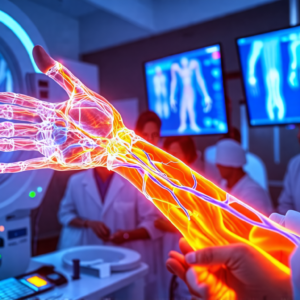Fluorescein Angiography Enhances the Precision of Carpal Tunnel Surgical Diagnoses
Carpal tunnel syndrome, a prevalent form of chronic nerve compression neuropathy, has long posed challenges in terms of accurate diagnosis and effective surgical intervention. A new study led by a team from Osaka Metropolitan University has shed light on a promising technique that could revolutionize the approach to diagnosing and treating this condition: fluorescein angiography.
Research Objective
The primary goal of the research was to investigate the utility of fluorescein angiography in visualizing and assessing neural blood flow in chronic nerve compression neuropathies. Understanding changes in neural blood flow is critical in diagnosing and determining the severity of conditions like carpal tunnel syndrome.
Methodology
The researchers utilized fluorescein angiography, a technique already established in neurosurgery and ophthalmology for highlighting blood vessels. Their study encompassed both animal models, including rats and rabbits, and human patients undergoing open carpal tunnel release surgery. This dual approach allowed for a comprehensive evaluation of the technique’s diagnostic capabilities.
By comparing the findings from fluorescein angiography with traditional electrodiagnostic testing, the team sought to validate the precision and accuracy of this novel approach.
Findings
The study yielded promising results. Fluorescein angiography was able to detect decreases in neural blood flow in both animal models and human patients experiencing chronic nerve compression neuropathy. Furthermore, the results demonstrated a strong correlation with electrodiagnostic tests, verifying the technique’s potential for high diagnostic accuracy.
Clinical Implications
The application of fluorescein angiography in carpal tunnel surgery could significantly enhance surgical outcomes. By allowing surgeons to visually identify areas with decreased neural blood flow due to chronic nerve compression, the technique aids in improving diagnostic accuracy, assessing the severity of the condition, and predicting surgical outcomes.
Graduate student Kosuke Saito highlighted the potential impact of fluorescein angiography, noting its ability to visualize impaired areas and assess the severity of the impairment. This capability could lead to more accurate and effective surgical interventions.
Conclusion
The findings suggest that fluorescein angiography holds significant promise for enhancing the accuracy and outcomes of surgeries targeting severe chronic nerve compression neuropathies, such as carpal tunnel syndrome. By providing a more precise understanding of neural blood flow impairment, this technique could revolutionize the approach to diagnosing and treating these challenging conditions.
